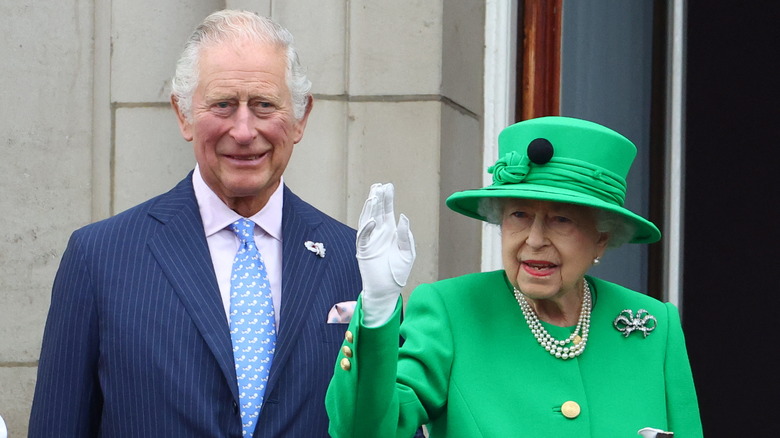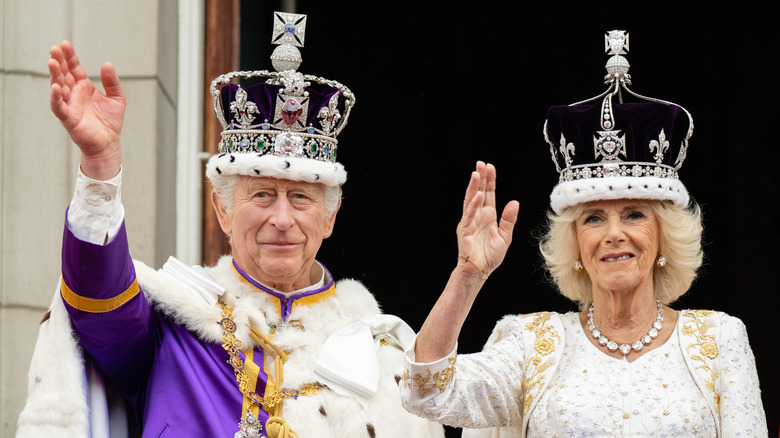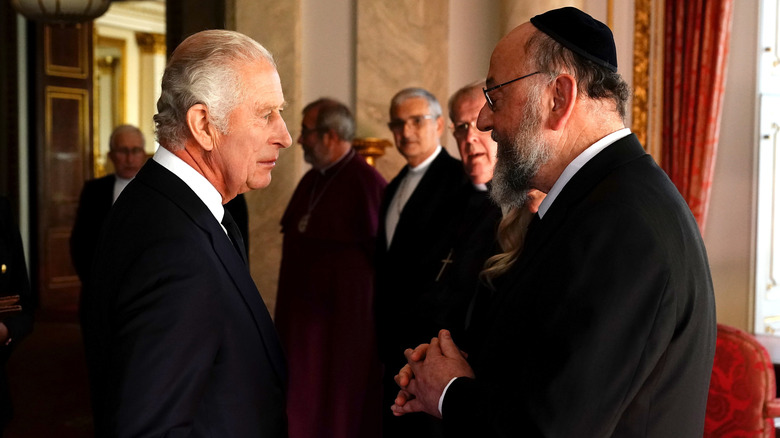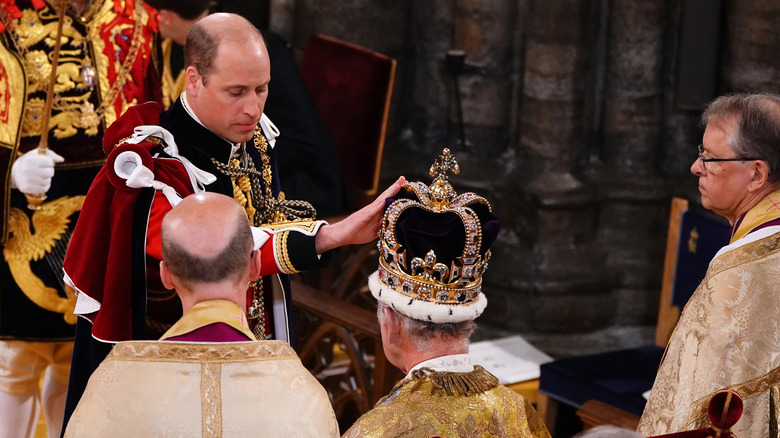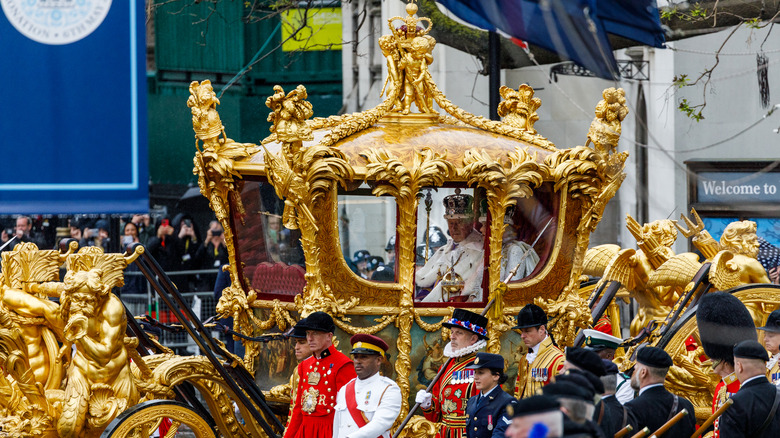5 Times King Charles Broke Tradition From Queen Elizabeth's Coronation
On Saturday, May 6, King Charles III was officially crowned the 40th British monarch. It was a lavish affair with glittering parades, royals dressed in their best (although some coronation guests dressed in their worst), excited crowds, and, at the end of it all, a new king and queen were crowned. King Charles' Coronation marks the first one in 70 years. The last coronation took place in 1953 when the late Queen Elizabeth II received the very same crown that now rests on her son's head.
Royalty is governed by tradition in so many ways, so it shouldn't be a surprise to learn that the two historic occasions were very similar. As is custom, the coronation of King Charles and his mother both took place in Westminster Abbey. Since as far back as 1066, Westminster Abbey's website notes that the timeless beauty of their olden church has been the backdrop for all coronations.
However, in 70 years, a lot can change, and a lot has. From his guest list to the crowning of his spouse, King Charles' Coronation broke tradition from that of Queen Elizabeth's numerous times.
Queen Camilla was also crowned
There has been much to say about King Charles in the past decades. Plenty of people were rubbed the wrong way during the then-Prince Charles tumultuous marriage with Princess Diana, but we have to say: King Charles might very well be taking strides towards redemption. He made sure that his wife Queen Camilla received quite literally the royal treatment during the coronation, and it was a breath of fresh air. Although the spotlight was on King Charles III, who has succeeded his mother as monarch of the United Kingdom, Queen Camilla was also a prominent participant in the ceremony. She was anointed right after her husband, and the coveted Queen Mary's crown was placed atop her head (via USA Today). She also received the title of "Queen Consort" as indicated by Queen Elizabeth II before her passing.
It was a different story for Queen Elizabeth's husband, Prince Philip. Insider reports that he did participate in the coronation ceremony by pledging his allegiance to his wife, but he wasn't crowned a king. He wasn't given the title of "King Philip," either. This is most likely because he'd have outranked Queen Elizabeth if he received the title, but an official statement on the matter has yet to be released.
King Charles had a shorter, more diverse guest list
Queen Elizabeth had no shortage of guests invited to her coronation. According to USA Today, over 8,000 guests showed up to watch the historic crowning of the new queen. The surplus of invitees meant the church had to be closed off to the public for a few days. This was so they could make a few modifications to accommodate such a huge crowd.
King Charles' guest list was much shorter than his mother's. Per Town & Country, his guest list came out to less than 2,300 people. Many members of the royal family and foreign royals were invited to attend the historic occasion, but it seems like King Charles wanted to make this a smaller, more intimate occasion than the 1953 coronation.
He also made an effort to include more religious diversity at the ceremony. While the coronation was still very Anglican, as was his mother's, the monarch took the time to invite and include several leaders of different faith communities in the coronation (via The Jewish Chronicle).
For the first time ever, social media was present for a coronation
When her father passed away suddenly, a 25-year-old Queen Elizabeth II, as heir to the throne, had to step up and take over rule as the next monarch. It was 1953 when her coronation took place, and it went down in history as being the first televised coronation. Capturing this once-in-a-lifetime moment was a huge occasion. Per the U.K. National Archives, media was staffed all around London to get as much footage as possible of the live event.
While television played a huge role in his mother's coronation, King Charles' Coronation was heralded by social media. It was the first coronation to take place since the invention of the technology. Apps like Twitter, Facebook, and Instagram made real-time updates and commentary on the event available to anyone with a smartphone. Better yet, everyday citizens could throw in their thoughts and even their own photos of royals if they were lucky enough to be in the crowd.
One of his sons participated in the coronation
The youngest son of Prince William and Princess Kate of Wales may have a bit of a reputation for disliking royal events, as this exclusive The List video of Prince Louis letting loose after the coronation shows, but he isn't alone. We're starting to think he got his lack of enthusiasm for formal occasions from his grandfather, King Charles III. During Queen Elizabeth's Coronation, Charles, who was four years old at the time, was famously captured in a photo where he looked absolutely done with the hours-long coronation (via New York Post). In the picture, young Charles stared desolately down into the abyss, his cheek resting on his hand, his face the picture of boredom as he watched the ceremony carry on without him.
Maybe — and we know it's a stretch — but maybe that's part of the reason why King Charles III decided to include one of his sons in the ceremony — although both his children are much older than he was at the time of his mother's coronation. While Harry was very noticeably placed on the sideline for the event, William knelt and pledged his allegiance to his father. According to People, William's Homage of Royal Blood was a vow similar to the one Prince Philip made to Queen Elizabeth.
His procession took a different route (and a different coach)
If you want to be part of the excitement of the coronation, you have to be there for the beautiful processions to and from Buckingham Palace. This is when the monarch-to-be is carried down a pre-planned route for everyone to witness during coronation day. During this time, throngs of people flank the streets to catch the display of royals carried in glorious carriages, a sea of parading horses, and stone-faced soldiers watching over it all. Famously, Queen Elizabeth's 1953 procession back to Buckingham Palace after her coronation at Westminster Abbey was five miles long (via Telegraph). Her route took her all the way to Oxford Circus and Hyde Park, giving plenty of her people time to see her during the trip.
King Charles' Coronation Procession broke that tradition, causing discontent for people eager to get a glimpse of the new monarch. In comparison to his mother's procession route, King Charles' route was less than two miles. He also took the Diamond Jubilee Coach instead of the Gold State Coach to Westminster Abbey, unlike his mother, who took the Gold State Coach to and from the church.
